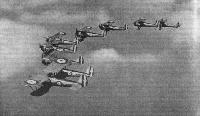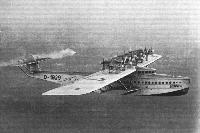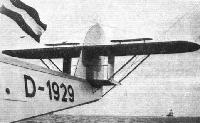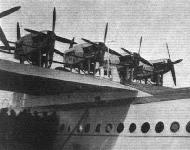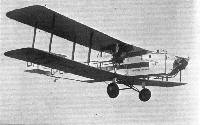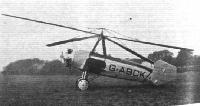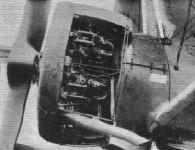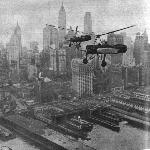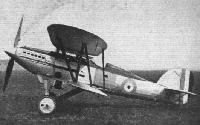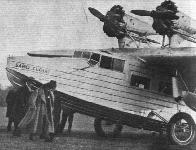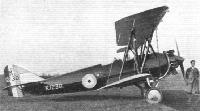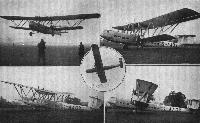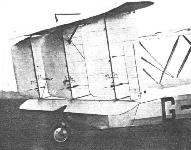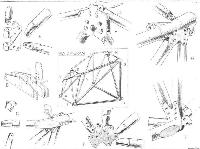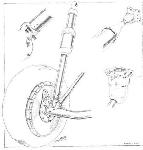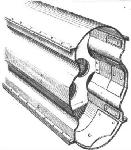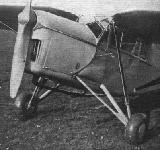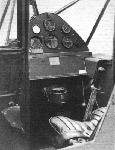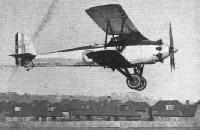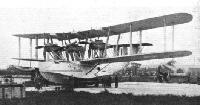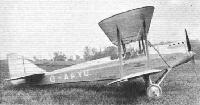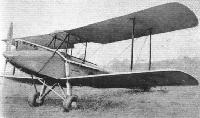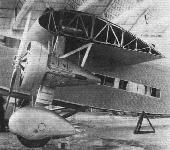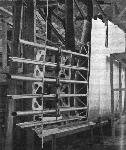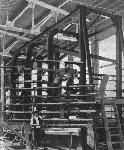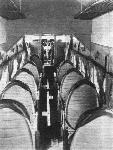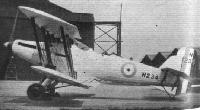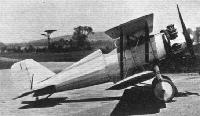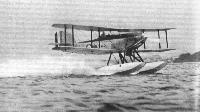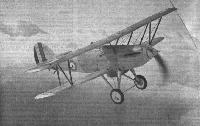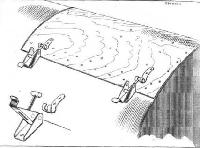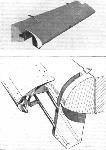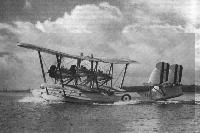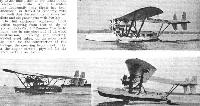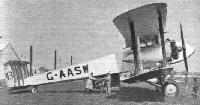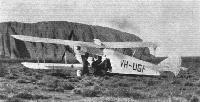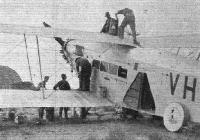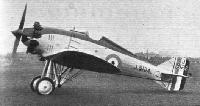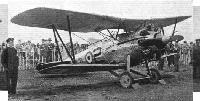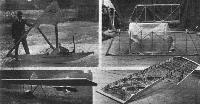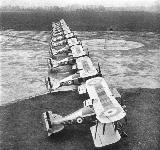Фотографии
-
A formation of Bristol Bulldogs.
Самолёты на фотографии: Bristol Bulldog - Великобритания - 1927
-
AT BALDONNELL AERODROME: The Bristol Fighter is another type employed by the Irish Free State Army Air Corps.
Самолёты на фотографии: Bristol F.2A/F.2B Fighter - Великобритания - 1916
-
Регистрационный номер: D-1929 [3] EN ROUTE FOR ENGLAND: An aerial view showing the Dornier Do.X flying over the Rhine en route for Amsterdam on the first stage of her flight to America, via England and Lisbon.
Самолёты на фотографии: Dornier Do.X - Германия - 1929
-
Регистрационный номер: D-1929 [3] Another view of the "flying ship" at her moorings.
Самолёты на фотографии: Dornier Do.X - Германия - 1929
-
Регистрационный номер: G-ABCJ "Do.X" AND THE SARO "CLOUD." - This view showing the "Cloud," with the Prince on board, alighting alongside the "Do.X," illustrates the similarity of these two machines.
Самолёты на фотографии: Dornier Do.X - Германия - 1929Saunders-Roe Cloud / A.19 - Великобритания - 1930
-
Регистрационный номер: D-1929 [3] SOME DETAILS OF THE DO.X: A close-up of the tail.
Самолёты на фотографии: Dornier Do.X - Германия - 1929
-
SOME DETAILS OF THE DO.X: Some of the twelve 600 h.p. Curtiss "Conqueror" engines
Самолёты на фотографии: Dornier Do.X - Германия - 1929
-
SOME DETAILS OF THE DO.X: The control cabin.
Самолёты на фотографии: Dornier Do.X - Германия - 1929
-
Регистрационный номер: G-EBLF The A. W. Argosy, a type which was put into service by Imperials in July, 1926, and brought the possibility of unsubsidised air transport a stage nearer.
Самолёты на фотографии: Armstrong Whitworth Argosy - Великобритания - 1926
-
Регистрационный номер: OO-AGF Westland Wessex built for Belgian air lines.
Самолёты на фотографии: Westland Wessex / Westland IV - Великобритания - 1929
-
AT BALDONNELL AERODROME: A Vickers "Vespa" (Armstrong Siddeley "Jaguar"), one of the types used by the Irish Free State Army Air Corps.
Самолёты на фотографии: Vickers Vespa / Type 113 - Великобритания - 1925
-
Vickers Vespa Army Co-operation biplane.
Самолёты на фотографии: Vickers Vespa / Type 113 - Великобритания - 1925
-
Parnall Elf 2-seater light aeroplane. (Cirrus Hermes engine.)
Самолёты на фотографии: Parnall Elf - Великобритания - 1929
-
Регистрационный номер: G-ABDO THE ROBINSON "REDWING MARK II": This side view shows that the lines of the fuselage are good, in spite of the side-by-side seating. Note the unusual shape of the rudder, which gives the machine a distinctive appearance.
Самолёты на фотографии: Robinson Redwing - США - 1930
-
Регистрационный номер: G-ABCK Cierva Autogiro C.19 Mark III Light Aeroplane.
Самолёты на фотографии: Cierva/Avro C.19 - Великобритания - 1929
-
The Boulton and Paul Townend Ring is combined with the exhaust collector. Some of the panels removed to show accessibility.
Самолёты на фотографии: Boulton Paul Sidestrand / P.29 - Великобритания - 1926
-
Регистрационный номер: G-AAIT THE "PHOENIX" (SALMSON) An original little aircraft produced by Boulton and Paul at Norwich.
Самолёты на фотографии: Boulton Paul Phoenix / P.41 - Великобритания - 1929
-
Регистрационный номер: D-1851, D-1942 THREE RECENT FOCKE-WULF TRANSPORT PLANES: The A.32 "Bussard" six-passenger cabin monoplane (280 h.p. Junkers "L-5"), the A.33 "Sperber" for three passengers (145-h.p. Walter "Mars"), and the F.19a "Ente," the interesting "tail-first" machine.
Самолёты на фотографии: Focke-Wulf A.20 Habicht / A.32 Bussard / A.33 Sperber - Германия - 1927Focke-Wulf F 19 Ente - Германия - 1927
-
AUTOGIROS OVER NEW YORK: Two Pitcairn Autogiros recently carried out some flights over New York City to determine the effect of wind currents among the "skyscrapers," and to find possible landing-places. Our picture shows the two machines flying up the river from New York Harbour.
Самолёты на фотографии: Pitcairn PCA-2 - США - 1931
-
Fairey Firefly III M single-seater ship's fighter.
Самолёты на фотографии: Fairey Firefly - Великобритания - 1925
-
Регистрационный номер: S1272 Blackburn Ripon
Самолёты на фотографии: Blackburn Ripon / T.5 - Великобритания - 1926
-
Регистрационный номер: J9714, J9728 Above: Westland Wapiti general purpose machine. Below: Westland Wapiti Army Co-operation machine.
Самолёты на фотографии: Westland Wapiti - Великобритания - 1927
-
Регистрационный номер: J9154 THE FAIREY "GORDON": A two-seater day bomber with Armstrong-Siddeley Panther engine.
Самолёты на фотографии: Fairey Gordon / Seal - Великобритания - 1931
-
H.R.H. The Prince of Wales inspects the Saro "Cloud" before flying to Calshot to see the "Do.X."
Самолёты на фотографии: Saunders-Roe Cloud / A.19 - Великобритания - 1930
-
Vickers Vildebeest torpedo-plane and bomber.
Самолёты на фотографии: Vickers Vildebeest / Type 132 - Великобритания - 1928
-
Avro Trainer school machine. (Lynx engine.)
Самолёты на фотографии: Avro Tutor/Sea Tutor/Prefect / Type 621/646/626 - Великобритания - 1929
-
Регистрационный номер: K1230 Avro Trainer school machine. Armstrong-Siddeley Mongoose engine.
Самолёты на фотографии: Avro Tutor/Sea Tutor/Prefect / Type 621/646/626 - Великобритания - 1929
-
Регистрационный номер: G-AAGX [2] Handley Page 42
Самолёты на фотографии: Handley Page H.P.42 / H.P.45 - Великобритания - 1930
-
Регистрационный номер: G-AAGX [2] HANDLEY PAGE 42-SEATER: The photographs show this new large passenger aeroplane on the ground and ni the air. In front of the wings is a saloon for 18 passengers while the rear saloon will accommodate 20 more. Machines of this type will be used by Imperial Airways on the routes Croydon-Salonika and Cairo-Karachi.
Самолёты на фотографии: Handley Page H.P.42 / H.P.45 - Великобритания - 1930
-
The elevator is of Duralumin construction, with rigid drag bracing.
Самолёты на фотографии: Handley Page H.P.42 / H.P.45 - Великобритания - 1930
-
THE TAIL: Rudder balances of an unusual type are used. These take the form of separate surfaces, placed some distance from, but linked to, the outer rudders. The balances are provided with fixed slots.
Самолёты на фотографии: Handley Page H.P.42 / H.P.45 - Великобритания - 1930
-
The tail plane is, like the main wings and control surfaces, of Duralumin construction.
Самолёты на фотографии: Handley Page H.P.42 / H.P.45 - Великобритания - 1930
-
DETAILS OF FUSELAGE CONSTRUCTION: 1, shows the bulkhead which carries the front wing spar. Note the section of this longeron. In 2 is shown the bulkhead attachment of interplane struts, while 3 is a corner of the bulkhead Carrying rear spar fittings. This was sketched while lying on its side. The details of the diagonal skin bracing are illustrated in 4.
Самолёты на фотографии: Handley Page H.P.42 / H.P.45 - Великобритания - 1930
-
Details of rear portion of fuselage, which is of welded steel tube construction. The key diagram shows extreme stern portion.
Самолёты на фотографии: Handley Page H.P.42 / H.P.45 - Великобритания - 1930
-
One-half of the Oleo-pneumatic undercarriage. The ball and socket joint of the radius rod has an internal plug of phosphor bronze, screwed into the outer casing and locked in position by the bolts passing through the castellations in the top of the bush.
Самолёты на фотографии: Handley Page H.P.42 / H.P.45 - Великобритания - 1930
-
The main wing spars are of built-up box section.
Самолёты на фотографии: Handley Page H.P.42 / H.P.45 - Великобритания - 1930
-
Регистрационный номер: K1824 CABIN AEROPLANE FOR THE ROYAL AIR FORCE. - A D.H. "Puss Moth" de luxe high speed communication aeroplane has been purchased by the Air Ministry for trial by the Royal Air Force. We show three views of this machine. Normal service aircraft of the open cockpit variety necessitate the wearing of special flying clothing, but with the all-enclosed cabin of the Puss Moth extra clothing of any sort is rendered superfluous. Although built in the first instance as a purely civil aeroplane, the Puss Moth will perform aerobatic flying when necessary and has a cruising speed of well over 100 m.p.h. It holds three persons and covers 22 miles on a gallon of petrol.
Самолёты на фотографии: De Havilland Puss Moth / D.H.80 - Великобритания - 1929
-
1931 MODELS: One of views showing the latest De Havilland developments: The Puss Moth will have balloon tyres "Doughnuts" and wheel brakes as standard, and in addition have the oblique windows in front of the pilot made to open
Самолёты на фотографии: De Havilland Puss Moth / D.H.80 - Великобритания - 1929
-
"ENTERPRISE"!: An interior view of the 1931 model "Puss-Moth," which is being shown at the Paris Show. D.H. thoroughness is exemplified by all notices and instrument dials being engraved in the French language.
Самолёты на фотографии: De Havilland Puss Moth / D.H.80 - Великобритания - 1929
-
AN ITALIAN HELICOPTER: An interesting photograph of the D'Ascanio helicopter in flight at the Ciampino Nord Aerodrome.
Самолёты на фотографии: D'Ascanio helicopter - Италия - 1930
-
Handley Page Hare day bomber.
Самолёты на фотографии: Handley Page Hare / H.P.34 - Великобритания - 1928
-
Blackburn Iris III flying-boat.
Самолёты на фотографии: Blackburn Iris / R.B.1 - Великобритания - 1926
-
Регистрационный номер: G-AAYU Avro Avian light aeroplane 2-seater.
Самолёты на фотографии: Avro Avian / Type 594/616 - Великобритания - 1926
-
AN AVIAN DEVELOPMENT: A view of an Avian belonging to the Lancashire Aero Club which is now fitted with 22 in. by 10 in. Goodyear Balloon tyres.
Самолёты на фотографии: Avro Avian / Type 594/616 - Великобритания - 1926
-
FOR "FEEDER LINE" OR PRIVATE OWNER: The De Havilland "Hawk Moth" (Moth Six) is a four-seater with provision for being turned into a six-seater for flights of shorter range. The machine shown is fitted with "Lynx" engine, but can also be supplied fitted with the Wright J.6. With either power plant it can be supplied as a seaplane.
Самолёты на фотографии: De Havilland Hawk Moth / D.H.75 - Великобритания - 1928
-
Регистрационный номер: G-ABEF TYPE 4-AT-E: Fitted with three Wright "Whirlwind" engines, this is the smaller of the two machines now in Europe.
Самолёты на фотографии: Ford Tri-Motor / 4-AT / 5-AT - США - 1926
-
THE TYPE 5-AT-C: The wing ends were not yet in place when this photograph was taken at Hooton. Note the tank inside the centre section, and the cowling ring around the "Wasp" engine.
Самолёты на фотографии: Ford Tri-Motor / 4-AT / 5-AT - США - 1926
-
FORD WING SPAR CONSTRUCTION: Built of Duralumin, the spar has "D"-section flanges, as shown on the right in A, while the vertical and diagonal struts are plain channel sections, as in B.
Самолёты на фотографии: Ford Tri-Motor / 4-AT / 5-AT - США - 1926
-
FORD WING CONSTRUCTION: There are three main spars, built up as shown on p.1234, and between them light stringers of U section, as in C. The struts of the stringer system are of the section shown in D.
Самолёты на фотографии: Ford Tri-Motor / 4-AT / 5-AT - США - 1926
-
A WING TIP NEARING COMPLETION: Note the type of rib used near the wing tip, and the disappearance, due to taper, of the N girders of the spars.
Самолёты на фотографии: Ford Tri-Motor / 4-AT / 5-AT - США - 1926
-
ASSEMBLING IN A VERTICAL JIG: This photograph, taken in the Dearborn works of the Ford Company, gives a good idea of the elaborate jigging used in wing assembly. The wings are erected leading edge downwards.
Самолёты на фотографии: Ford Tri-Motor / 4-AT / 5-AT - США - 1926
-
THE TYPE 5-AT-C: The castor-section tail wheel.
Самолёты на фотографии: Ford Tri-Motor / 4-AT / 5-AT - США - 1926
-
THE FORD 4-AT-E: Note the streamline fairings over the wheels. The propellers are standard metal airscrews with adjustable pitch blades. Starting is by means of hand-operated inertia starters, one being carried in each nacelle and one in the fuselage.
Самолёты на фотографии: Ford Tri-Motor / 4-AT / 5-AT - США - 1926
-
THE COCKPIT OF A THREE-ENGINED FORD: The central lever operates the wheel brakes (hydraulic).
Самолёты на фотографии: Ford Tri-Motor / 4-AT / 5-AT - США - 1926
-
THE CABIN: In the floor may be seen the special louvres which admit warm air. The open door shows a little of the pilots' cockpit.
Самолёты на фотографии: Ford Tri-Motor / 4-AT / 5-AT - США - 1926
-
Регистрационный номер: N236 Blackburn Beagle.
Самолёты на фотографии: Blackburn Beagle / BT.1 - Великобритания - 1928
-
Регистрационный номер: N234 Blackburn Nautilus.
Самолёты на фотографии: Blackburn Nautilus / 2F.1 - Великобритания - 1929
-
Самолёты на фотографии: Blackburn Lincock / F.2 - Великобритания - 1928
-
Регистрационный номер: N241 Blackburn Sydney flying-boat.
Самолёты на фотографии: Blackburn Sydney / R.B.2 - Великобритания - 1930
-
Model of Blackburn Nile
Самолёты на фотографии: Blackburn Sydney / R.B.2 - Великобритания - 1930
-
WITH the "Swift," Mr. Comper has proved that high performance can be obtained with low horsepower. Although the engine is an A.B.C. "Scorpion" of 38 h.p. only, the machine has a top speed of more than 100 m.p.h., and cruises at 85 m.p.h. on a very low fuel consumption.
Самолёты на фотографии: Comper Swift / CLA.7 - Великобритания - 1930
-
Регистрационный номер: G-AAZF A COMPER SWIFT (POBJOY): Being demonstrated by Flt. Lt. N. Comper, with engine the Swift has a performance like a small fighter.
Самолёты на фотографии: Comper Swift / CLA.7 - Великобритания - 1930
-
Регистрационный номер: G-AAZC Comper Swift light aeroplane single-seater (50-h.p. Salmson engine)
Самолёты на фотографии: Comper Swift / CLA.7 - Великобритания - 1930
-
Самолёты на фотографии: Handley Page Hyderabad/H.P.24 / Hinaidi/H.P.33 / Clive/H.P.35 - Великобритания - 1923
-
Handley Page Clive Troop Carrier.
Самолёты на фотографии: Handley Page Hyderabad/H.P.24 / Hinaidi/H.P.33 / Clive/H.P.35 - Великобритания - 1923
-
De Havilland Hercules passenger carrier (three Bristol Jupiters)
Самолёты на фотографии: De Havilland Hercules / D.H.66 - Великобритания - 1926
-
Регистрационный номер: G-AAYZ A SINGLE-SEATER light 'plane with very fine performance. Of mixed construction. Engines fitted: A.B.C. "Hornet," Armstrong-Siddeley "Genet" and "Gipsy II."
Самолёты на фотографии: Southern Martlet - Великобритания - 1929
-
Регистрационный номер: G-AAYX Southern Martlet. Genet Major engine.
Самолёты на фотографии: Southern Martlet - Великобритания - 1929
-
A FAIREY IN CANADA: One of the Fairey III F seaplanes, fitted with a Series XI Napier "Lion" employed by the Royal Canadian Air Force at Vancouver. The machine is seen taking off at Jericho Beach.
Самолёты на фотографии: Fairey Fairey IIIF - Великобритания - 1926
-
Регистрационный номер: J9640 Fairey III F general purpose machine. (Napier Lion engine.)
Самолёты на фотографии: Fairey Fairey IIIF - Великобритания - 1926
-
Регистрационный номер: N235 Fairey Fleetwing 2-seater fleet fighter.
Самолёты на фотографии: Fairey Fleetwing - Великобритания - 1929
-
Saro Cutty Sark 4-seater flying-boat.
Самолёты на фотографии: Saunders-Roe Cutty Sark / A.17 - Великобритания - 1929
-
Hawker Fury single-seater fighter.
Самолёты на фотографии: Hawker Hornet / F.20/27 - Великобритания - 1928
-
Регистрационный номер: G-AAWZ [4] Самолёты на фотографии: Spartan Arrow - Великобритания - 1930
-
Регистрационный номер: G-AAWZ [4] THE SPARTAN "ARROW": Three-quarter front view. The engine is a "Gipsy II."
Самолёты на фотографии: Spartan Arrow - Великобритания - 1930
-
Регистрационный номер: G-AAWZ [4] AN UNDERNEATH VIEW: The Spartan "Arrow" flying at Hamble
Самолёты на фотографии: Spartan Arrow - Великобритания - 1930
-
Регистрационный номер: G-AAWZ [4] THE SPARTAN "ARROW" (GIPSY II): This Side View illustrates well the pleasing lines of the machine. Note that the rudder is of a shape quite different from that of the older Spartans.
Самолёты на фотографии: Spartan Arrow - Великобритания - 1930
-
THE VERY NEAT PETROL TANK: The photograph shows the centre-section with tank in place, while the sketches illustrate the fastening of the tank, and also the locking of the pin used in the wing folding.
Самолёты на фотографии: Spartan Arrow - Великобритания - 1930
-
A NEAT CLIP: The sketch illustrates the clip on the door of the luggage locker, but the same type of clip is used elsewhere.
Самолёты на фотографии: Spartan Arrow - Великобритания - 1930
-
INTERCHANGEABILITY: This diagrammatic view shows how the two parts, A and B, of the trailing portion of the wing can be used in any position. The wing tip can be fitted at either end of the wing. The type of hinge employed for the aileron and trailing edge is shown at H, while the two smaller insets show a spar section and the construction of a wing rib.
Самолёты на фотографии: Spartan Arrow - Великобритания - 1930
-
THE SLOT UNIT: The photograph shows the complete unit, while the sketch illustrates the torque tube which ensures parallel opening of the slot.
Самолёты на фотографии: Spartan Arrow - Великобритания - 1930
-
ON THE SPARTAN "ARROW": The new lower plane wing root is braced from the fuselage, with which it is integral, by two struts.
Самолёты на фотографии: Spartan Arrow - Великобритания - 1930
-
PARIS GETTING READY FOR THE SHOW: This photograph shows a corner of the Grand Palais where the 12th International Aero Show opens on Friday of this week. The twin-fuselage Bleriot monoplane will be one of the "sights" of the Show. The machine on the right is a Liore & Olivier 4-engined Bomber, while the Commercial Monoplane in the foreground is of unknown parentage.
Самолёты на фотографии: Bleriot Bleriot-125 - Франция - 1931Liore et Olivier LeO 203 / 204 / 206 - Франция - 1930SPCA Type 40T / 41T - Франция - 1929
-
Регистрационный номер: N252 The three-engined Southampton Mk X of 1930, N252, had a stainless steel hull. It is seen here in 1930 with 520 h.p. Armstrong Siddeley Panther IIA engines, having previously been flown with 490 h.p. Jaguars and 595 h.p. Jupiters.
Самолёты на фотографии: Supermarine Southampton / Solent - Великобритания - 1925
-
Регистрационный номер: NC806W Another Sikorsky: The S.39, a smaller version of the Sikorsky Amphibians, fitted with a 300 h.p. Pratt and Whitney "Wasp Junior" and carrying pilot and four passengers. This machine has been supplied to Personal Flying Services, Ltd.
Самолёты на фотографии: Sikorsky S-39 - США - 1929
-
Three views of the new Sikorsky S.41, a large amphibian, similar to the well-known S.38, which has been supplied to Pan-American Airways.
Самолёты на фотографии: Sikorsky S-41 - США - 1930
-
Регистрационный номер: G-AAUB Vickers Viastra passenger carrier. Two Jaguars.
Самолёты на фотографии: Vickers Viastra / Type 160 - Великобритания - 1930
-
Регистрационный номер: G-AASW Vickers Vellore high-speed freight carrier
Самолёты на фотографии: Vickers Vellore / Vellox - Великобритания - 1928
-
Регистрационный номер: NX237 THE ATLANTIC VETERAN: The Bellanca monoplane "Miss Columbia," which has made three Atlantic crossings, is now operated by Personal Flying Services, Ltd., of London, for air taxi work, etc. Our picture shows it at Croydon prior to Capt. Boyd's flight to Berlin this week.
Самолёты на фотографии: Wright-Bellanca WB-1 / WB-2 - США - 1925
-
Регистрационный номер: VH-UGF [2] The ANEC biplane, "Love Bird," of Australian Aerial Services at Ayer's Rock, on the first occasion of landing there. The Rock is two miles away.
Самолёты на фотографии: ANEC III - Великобритания - 1926
-
Регистрационный номер: VH-UGF [2] Filling up the "Love Bird" with "Shell" at Ayer's Rock before setting out on the last flight over unknown country to Cook. This was the first time an aeroplane had ever landed near the Rock or flown over Noman's Land to Cook.
Самолёты на фотографии: ANEC III - Великобритания - 1926
-
Регистрационный номер: G-ABAZ A Spartan 3-seater (Gipsy II) flying over Southampton Water.
Самолёты на фотографии: Simmonds Spartan - Великобритания - 1928
-
Регистрационный номер: G-AAAA De Havilland Gipsy-Moth two-seater light aeroplane
Самолёты на фотографии: De Havilland Gipsy Moth / Moth X - Великобритания - 1928
-
1931 MODELS: One of the views showing the latest De Havilland developments: The standard Moth will have balloon tyres "Doughnuts" and wheel brakes as standard, and a particularly comfortable Triplex Wind Screen for the pilot's cockpit.
Самолёты на фотографии: De Havilland Gipsy Moth / Moth X - Великобритания - 1928
-
Регистрационный номер: J9124 Westland Interceptor fighter. Bristol Mercury engine.
Самолёты на фотографии: Westland Interceptor F20/27 / F.29/27 COW Gun Fighter - Великобритания - 1929
-
A new low wing Monoplane in this country is the Caudron ("Renault," 95 h.p.), which is the property of H. Swann, of the L.C.C., who is believed to be the first member of that august body owning his own aircraft.
Самолёты на фотографии: Caudron C.190 - Франция - 1929
-
Регистрационный номер: G-AASO Avro Five, small commercial aeroplane.
Самолёты на фотографии: Avro Five / Type 619 / Six / Type 624 - Великобритания - 1929
-
Регистрационный номер: G-AAYR Avro Six small commercial aeroplane.
Самолёты на фотографии: Avro Five / Type 619 / Six / Type 624 - Великобритания - 1929
-
The Surrey Gliding Club's training glider being piloted in a very able manner by their instructor, Capt. Stratton.
Самолёты на фотографии: Lippisch / RRG Zogling - Германия - 1926
-
A BEGINNER'S HOP: The Surrey Gliding Club launching one of their beginners well down the slope of their training hill. Their instructor, who may be seen in front of the glider, runs along ano directs his pupils during their flight, by means of a megaphone.
Самолёты на фотографии: Lippisch / RRG Zogling - Германия - 1926
-
Регистрационный номер: VH-UMY THE "LASCONDOR" MONOPLANE: A three-engined (Armstrong-Siddeley "Mongoose"), seven-seater commercial machine, designed and built by the Larkin Co.
Самолёты на фотографии: Larkin (Lasco) Lascoter / Lascondor - Австралия - 1929
-
Регистрационный номер: J9051 The Bristol Bullpup is an single-seater interceptor Fighter.
Самолёты на фотографии: Bristol Bullpup - Великобритания - 1928
-
The new intermediate training type glider, built by the British Aircraft Co. at Maidstone, being flown by its designer, Mr. Lowe-Wylde.
Самолёты на фотографии: Lowe-Wylde Columbus / BAC.II - BAC.IX - Великобритания - 1930
-
A BRITISH GLIDER: A series of photographs showing the R.F.D. "Dagling" under construction at Mr. R. F. Dagnall's works at Guildford. The "Dagling" is an improved Zogling type, cleaned up to give greater efficiency.
Самолёты на фотографии: Slingsby T.3 Dagling - Великобритания - 1930
-
Регистрационный номер: J8040, J8084 The full complement of 12 Gloster Gamecocks (Jupiter engines) of No. 23 (Fighter) Squadron at Kenley.
Самолёты на фотографии: Gloster Gamecock - Великобритания - 1925
Статьи
- Flight
